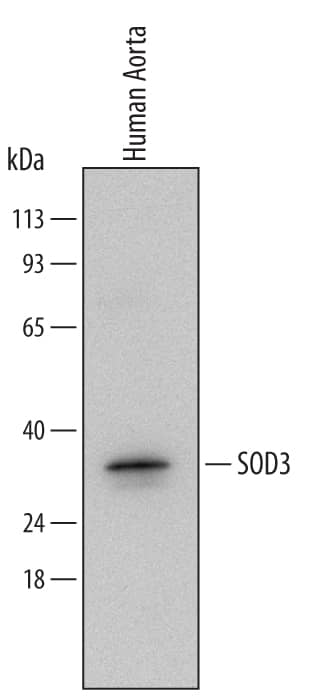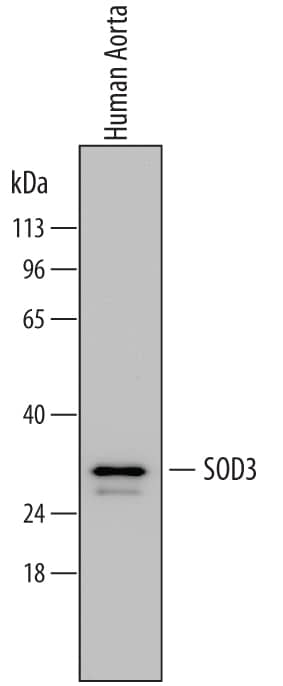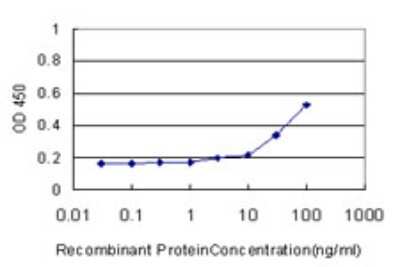SOD3/EC-SOD Products
Superoxide Dismutases, originally identified as Indophenoloxidases (IPOs), are enzymes that catalyze the conversion of naturally-occuring but harmful superoxide radicals into molecular oxygen and hydrogen peroxide. Three mammalian isozymes of SOD have been identified and are functionally related but have very modest sequence homology. SODs are typically soluble secreted or cytosolic proteins, but are also found in the mitochondria and extracellular matrix.
Any of three metals, manganese, iron, or copper, may be used in the active site of SOD and are indicative of cellular localization.MnSOD (SOD2) is found in the mitochondria of both prokaryotes and ukaryotes, whereas the cytosol of eukaryotes and prokaryotic organisms contains Cu/ZnSOD (SOD1) and FeSOD, respectively.
There have been several mutations identified in the Cu/ZnSOD (SOD1) gene in amyotrophic lateral sclerosis (ALS) patients, possibly suggesting a role for free radicals in this disease process. The mechanism of motor neuron degeneration that occurs in ALS, however, is unclear at this time. Several hypotheses have been explored for the role of mutant SOD1 and convincing evidence for the involvement of apoptosis has been presented, as well.
54 results for "SOD3/EC-SOD" in Products
54 results for "SOD3/EC-SOD" in Products
SOD3/EC-SOD Products
Superoxide Dismutases, originally identified as Indophenoloxidases (IPOs), are enzymes that catalyze the conversion of naturally-occuring but harmful superoxide radicals into molecular oxygen and hydrogen peroxide. Three mammalian isozymes of SOD have been identified and are functionally related but have very modest sequence homology. SODs are typically soluble secreted or cytosolic proteins, but are also found in the mitochondria and extracellular matrix.
Any of three metals, manganese, iron, or copper, may be used in the active site of SOD and are indicative of cellular localization.MnSOD (SOD2) is found in the mitochondria of both prokaryotes and ukaryotes, whereas the cytosol of eukaryotes and prokaryotic organisms contains Cu/ZnSOD (SOD1) and FeSOD, respectively.
There have been several mutations identified in the Cu/ZnSOD (SOD1) gene in amyotrophic lateral sclerosis (ALS) patients, possibly suggesting a role for free radicals in this disease process. The mechanism of motor neuron degeneration that occurs in ALS, however, is unclear at this time. Several hypotheses have been explored for the role of mutant SOD1 and convincing evidence for the involvement of apoptosis has been presented, as well.
| Reactivity: | Mouse |
| Details: | Goat IgG Polyclonal |
| Applications: | WB, Simple Western |
| Reactivity: | Human |
| Details: | Goat IgG Polyclonal |
| Applications: | WB, Simple Western, IHC |
| Reactivity: | Human, Mouse |
| Details: | Mouse IgG1 Monoclonal Clone #713707 |
| Applications: | WB, Simple Western |
| Reactivity: | Human, Mouse, Rat, Guinea Pig |
| Details: | Mouse IgG1 kappa Monoclonal Clone #4GG11G6 |
| Applications: | IHC, WB, ELISA, ICC/IF |
Recombinant Monoclonal Antibody
| Reactivity: | Human |
| Details: | Rabbit IgG Monoclonal Clone #SR1423 |
| Applications: | IHC, WB |
| Reactivity: | Human |
| Details: | Rabbit IgG Polyclonal |
| Applications: | IHC, WB |
| Applications: | WB, ELISA, MA, AP, PAGE |
| Reactivity: | Mouse |
| Details: | Rabbit IgG Polyclonal |
| Applications: | IHC, WB |
| Reactivity: | Human, Mouse, Rat |
| Details: | Rabbit IgG Polyclonal |
| Applications: | WB, ICC/IF |
| Applications: | AC |
| Reactivity: | Human |
| Details: | Mouse IgG2a Kappa Monoclonal Clone #5C3 |
| Applications: | WB, ELISA |
Recombinant Monoclonal Antibody
| Reactivity: | Human |
| Details: | Rabbit IgG Monoclonal Clone #JE31-84 |
| Applications: | WB |
| Reactivity: | Human |
| Details: | Mouse IgG2a Kappa Monoclonal Clone #C9 |
| Applications: | IHC |
| Reactivity: | Human, Mouse, Rat |
| Details: | Rabbit IgG Polyclonal |
| Applications: | WB, ICC/IF |
| Reactivity: | Human, Mouse, Rat |
| Details: | Rabbit IgG Polyclonal |
| Applications: | WB, ICC/IF |
| Reactivity: | Human, Mouse, Rat |
| Details: | Rabbit IgG Polyclonal |
| Applications: | WB, ICC/IF |
| Reactivity: | Human, Mouse, Rat |
| Details: | Rabbit IgG Polyclonal |
| Applications: | WB, ICC/IF |
| Reactivity: | Human, Mouse, Rat |
| Details: | Rabbit IgG Polyclonal |
| Applications: | WB, ICC/IF |
| Reactivity: | Human, Mouse, Rat, Guinea Pig |
| Details: | Mouse IgG1 kappa Monoclonal Clone #4GG11G6 |
| Applications: | IHC, ELISA |
| Reactivity: | Human, Mouse, Rat, Guinea Pig |
| Details: | Mouse IgG1 kappa Monoclonal Clone #4GG11G6 |
| Applications: | IHC, ELISA |
| Reactivity: | Human, Mouse, Rat, Guinea Pig |
| Details: | Mouse IgG1 kappa Monoclonal Clone #4GG11G6 |
| Applications: | IHC, ELISA |
| Reactivity: | Human, Mouse, Rat |
| Details: | Rabbit IgG Polyclonal |
| Applications: | WB, ICC/IF |
| Reactivity: | Human, Mouse, Rat, Guinea Pig |
| Details: | Mouse IgG1 kappa Monoclonal Clone #4GG11G6 |
| Applications: | IHC, ELISA |
| Reactivity: | Human, Mouse, Rat, Guinea Pig |
| Details: | Mouse IgG1 kappa Monoclonal Clone #4GG11G6 |
| Applications: | IHC, ELISA |
| Reactivity: | Human, Mouse, Rat |
| Details: | Rabbit IgG Polyclonal |
| Applications: | WB, ICC/IF |





![Western Blot: SOD3/EC-SOD Antibody (4GG11G6) [NBP1-22417] Western Blot: SOD3/EC-SOD Antibody (4GG11G6) [NBP1-22417]](https://resources.bio-techne.com/images/products/SOD3-EC-SOD-Antibody-4GG11G6-Western-Blot-NBP1-22417-img0004.jpg)
![Western Blot: SOD3/EC-SOD Antibody (SR1423) [NBP3-21798] -](https://resources.bio-techne.com/images/products/nbp3-21798_rabbit-sod3-ec-sod-mab-sr1423-6720239533729.jpg)
![Western Blot: SOD3/EC-SOD Antibody [NBP2-38493] Western Blot: SOD3/EC-SOD Antibody [NBP2-38493]](https://resources.bio-techne.com/images/products/SOD3-EC-SOD-Antibody-Western-Blot-NBP2-38493-img0002.jpg)
![SDS-PAGE: Recombinant Human SOD3/EC-SOD GST (N-Term) Protein [H00006649-Q01] SDS-PAGE: Recombinant Human SOD3/EC-SOD GST (N-Term) Protein [H00006649-Q01]](https://resources.bio-techne.com/images/products/SOD3-EC-SOD-Partial-Recombinant-Protein-SDS-Page-H00006649-Q01-img0001.jpg)

![Western Blot: SOD3/EC-SOD Antibody [NBP3-18234] Western Blot: SOD3/EC-SOD Antibody [NBP3-18234]](https://resources.bio-techne.com/images/products/SOD3-EC-SOD)

![Western Blot: SOD3/EC-SOD Antibody (JE31-84) [NBP3-32985] SOD3/EC-SOD Antibody (JE31-84)](https://resources.bio-techne.com/images/products/nbp3-32985_rabbit-sod3-ec-sod-mab-je31-84-288202412493431.jpg)